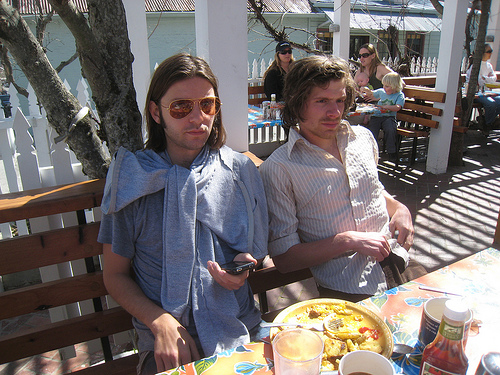When it came to food, my grandfather prized quantity. Maybe it was something about being a kid during the Depression and then an adult during World War II rationing, but he relished, like little else, walking into the dining room of a second-rate hotel restaurant, and seeing brunch laid out: a legion of steaming metal tubs on tables in rows, like shining shields, their handles swathed in white cloth napkins. There'd be a d.i.y waffle station to the left, a man shaking omelets to the right. Cascades of silly, under-ripe fruit would pile on circular tables here and there. There'd be a roast beef carving counter, little sausage links, pancakes, scrambled eggs, and lunch-like dishes -- baked chicken-y things, bad salads, mysterious gratins -- no one ever seemed to actually eat. He loved brunch, specifically buffets, because he could eat anything he wanted, in whatever sequence and amounts he desired. Brunch was freedom in the form of phony opulence. It reminded him of the cruises he adored, I think, an earthly manifestation of those magical floating worlds where dedicated gluttons could dine four times a day and hop freely from one bastardized culinary tradition to another.
In San Francisco, buffets are more luxurious than those I knew in Kentucky as a kid. On Sunday mornings, from 10:30 a.m. until 1:30 p.m., you can enjoy $68 worth of omelets made to order, sushi and sashimi, pasta, dim sum, crepes, breads, pastries, and desserts -- along with posh digs and about 800 tourists -- at the Court Garden of the Palace Hotel on the corner of Market and New Mongomery. The most trumpeted neighborhood brunch spots, typically buffet-less, are usually no less packed with locals. Brunch isn't breakfast. Breakfast happens on a walk from BART to work, right after a stop at Specialty's, or at a diner in the middle of Wyoming at 5 a.m. You eat breakfast because you're hungry. More than sustenance, brunch is a time to linger, a special occasion you get used to, even if you're having it around the corner from your apartment.
The ultimate slow feed originated in Britain, close to the end of the 1800s. Since the dawn of civilization, the privileged and wealthy had enjoyed leisurely, pleasurable meals at an expense of money and time unsustainable for poorer people. Brunch was a trendy expression of this long-running culinary tradition. While the meal itself would gain great popularity in the United States well after the turn-of-the-century, the name was coined in 1895 by Hunter's Weekly contributor Guy Beringer. In an article entitled "Brunch: A Plea", Beringer advocated the adoption of a new meal, offered around noon, to replace early Sunday dinner, that daunting afternoon ritual of gravy-sauced roasts and meat pastries Beringer found unduly rough on a booze-imbued stomach. "Brunch is cheerful, sociable and inciting," Beringer wrote, thinking of good toast, fine jams, and languorous mugs of coffee to precede heartier indulgences. "It is talk-compelling. It puts you in a good temper, it makes you satisfied with yourself and your fellow beings, it sweeps away the worries and cobwebs of the week."
Over a hundred years later, in his career-making 2001 book "Kitchen Confidential", celebrity face-stuffer Anthony Bourdain (I'd like to leave him be but he keeps popping up like a Whac-A-Mole at the county fair) notoriously took brunch's modern, evolved form to task:
"Brunch menus are an open invitation to the cost-conscious chef, a dumping ground for the odd bits left over from Friday and Saturday nights. How about hollandaise sauce? Not for me. Bacteria love hollandaise. And nobody I know has ever made hollandaise to order. And how long has that Canadian bacon been festering in the walk-in? Remember, brunch is only served once a week -- on the weekends. Cooks hate brunch. Brunch is punishment block for the B-Team cooks, or where the farm team of recent dishwashers learn their chops."
From outside the kitchen, the view is still a little bleak, or significantly brighter -- depending on where you stand. Stale bread breakfast casseroles, hash, and whatever-with-eggs may be unabashed second chances for unpopular dinner specials, leftovers slopped together by the bored, hung-over chefs inhabiting Bourdain's tableau. Yet the brunching masses greet them with enthusiasm all the same, dropping dinner-sized wads on scrambles, stacks, and the odd strata. For some urban professionals, a Sunday morning wouldn't be quite right without lingering al fresco at some cafe over granola, crumbly biscuits, vegan gravy, and a bottomless mimosa. For others, weekend mornings and early afternoons are times for errands and exercise. On their paths to such less idle pursuits, they worm their ways through throngs of shades-wearing folks holding out for coveted tables, seemingly with nothing better to do save wait. Brunch isn't just a meal, an enduring dining convention white people like -- along with modern furniture, Apple products, and other stuff. Today, it's a state of mind, and a polarizing one at that. Brunch-positive people work hard and play hard. They see brunch as a soothing extension of the partying they did the night before, a necessary putting back together of things that were dislodged -- a ritual well worth the inflated price of pancakes and a lengthy wait. Brunch-negative people think waiting for food they could make at home for a fraction of the cost is a waste of a day's best hours. There are two sides, and San Francisco's boutique-lined streets -- Haight, Church, Valencia -- are divided between them.
